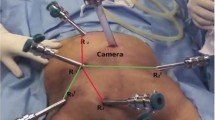Abstract
PURPOSE: We discuss our experience in radical rectal cancer surgery and critically review the results of the current literature. In particular, the importance of distal clearance, total excision of the mesorectum, and pelvic lymphadenectomy is stressed. METHODS AND RESULTS: The rationale for determining a pelvic lymphadenectomy is identified in the high percentage (20 percent) of lateral endopelvic metastatic nodes demonstrated in cases of extraperitoneal rectal cancers. The results after pelvic lymphadenectomy and the eventual complications are observed. The autonomic nerve-sparing procedure is described and the preliminary results, with a decreased rate of urinary and sexual sequelae, are discussed. CONCLUSIONS: It was concluded that, in cases of an advanced rectal cancer, radical surgery, if associated with the nervesparing technique, can improve survival without affecting the incidence of major complications.
Similar content being viewed by others
References
Church JM, Raudikivi PJ, Mill BL. The surgical anatomy of the rectum—a review with particular reference to the hazards of rectal mobilisation. Int J Colorectal Dis 1987;2:158–66.
Pollet WG, Nicholls RJ. The relationship between the extent of distal clearance and survival and local recurrence rates after curative anterior resection for carcinoma of the rectum. Ann Surg 1983;198:159–63.
Williams NS, Dixon MF, Johnston D. Reappraisal of the 5 centimeter rule of distal excision for carcinoma of the rectum: study of distal intramural spread and of patients' survival. Br J Surg 1983;70:150–4.
Di Matteo G, Cancrini A Jr, Boemi L, Mascagni D, Perri FA. The role of lymphadenectomy in rectal cancer. J Exp Clin Cancer Res 1989;8:26–33.
Enker WE, Laffer VT, Block GE. Enhanced survival of patients with colon and rectal cancer is based on wide anatomic resection. Ann Surg 1979;190:350–60.
Heald RJ, Husband EM, Ryall RD. The mesorectum in rectal cancer surgery—the clue to pelvic recurrence? Br J Surg 1982;69:613–6.
Heald RJ, Ryall RH. Recurrence and survival after total mesorectal excision for rectal cancer. Lancet 1986;1:1479–82.
Hojo K, Koyama Y, Moriya Y. Lymphatic spread and its prognostic value in patients with rectal cancer. Ann J Surg 1982;144:350–4.
Mascagni D, Hojo K, Moriya Y, Sugihara K, Di Matteo G. Pattern of lymph node metastasis from low rectal cancer. (Meeting abstr.) Dis Colon Rectum 1992;5:P6.
Mc AnenaOJ Heald RJ, Lockhart-Mummery MF. Operative and functional results of total mesorectal excision with ultra-low anterior resection in the management of carcinoma of the lower one-third of the rectum. Surg Gynecol Obstet 1990;170:517–21.
Moriya Y, Hojo K, Sawada T, Koyama Y. Significance of lateral node dissection for advanced rectal carcinoma at or below the peritoneal reflection. Dis Colon Rectum 1989;32:307–15.
Northover JM. The dissection in anterior resection for rectal cancer. Int J Colorectal Dis 1989;4:134–8.
Schardey HM. Intraluminal vs. extraluminal local recurrence of colo-rectal carcinoma. Absence of predisposing histopathological factors after RO resection. ACA Suppl 1991;93:21–2.
Feil W, Wunderlich M, Kovats E, Neuhold N, Schemper M, Wenzl E, Schiessel R. Rectal cancer: factors influencing the development of local recurrence after radical anterior resection. Int J Colorectal Dis 1988;3:195–200.
Miholic J, Loimer L, End A, Moeschl P, Wolner E. Risk factors for pelvic recurrence of rectal cancer. ACA Suppl 1991;93:22.
Cawthorn SJ, Parums DV, Gibbs NM,et al. Extent of mesorectal spread and involvement of lateral resection margin as prognostic factor after surgery for rectal cancer. Lancet 1990;335:1055–9.
Anderberg B, Enblad P, Sjodahl R, Wetterfors J. The EEA-stapling device in anterior resection for carcinoma of the rectum. Acta Chir Scand 1983;149:99–103.
Sauer I, Bacon HE. Influence of lateral spread of cancer of the rectum on radicability of operation and prognosis. Am J Surg 1951;81:111–20.
Goligher JC. Surgery of anus, rectum, and colon. 4th ed. London: Bailiere Tindall, 1980.
Di Matteo G, Mascagni D, Tarroni D. Radical surgery for rectal cancer. J Surg Oncol 1991;2(Suppl):32–5.
Hojo K, Vernava AM, Sugihara K, Katumata K. Preservation of urine voiding and sexual function after rectal cancer surgery. Dis Colon Rectum 1991;34:532–9.
Phillips RK, Hittinger R, Blesovsky L, Fry JS, Fielding LP. Local recurrence following “curative” surgery for large bowel cancer: II. The rectum and rectosigmoid. Br J Surg 1984;71:17–20.
Author information
Authors and Affiliations
About this article
Cite this article
Di Matteo, G., Mascagni, D., Lentini, A. et al. Advances in rectal cancer surgery. Dis Colon Rectum 37 (Suppl 2), S50–S53 (1994). https://doi.org/10.1007/BF02048432
Issue Date:
DOI: https://doi.org/10.1007/BF02048432




